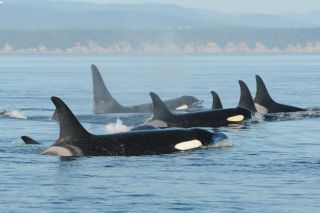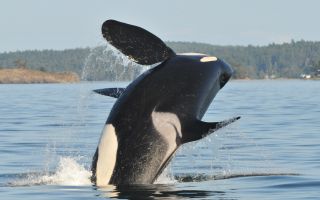Menopause
Post-Menopause Orca Moms Protect Their Sons
Male orcas with older moms get into fewer scraps with other orcas.
Posted July 20, 2023 Reviewed by Gary Drevitch
Key points
- Orcas (killer whales) are one of the few species, in addition to humans, to experience menopause.
- Male orcas with post-menopause mothers have fewer scars from socially-inflicted injuries.
- Older female orcas do not lower the number of injuries in their daughters or grandoffspring of either sex.
- This targeted social support toward sons may be an additional pathway by which menopause is adaptive in orcas.

Menopause presents an evolutionary mystery: Why should females spend a significant portion of their lives not reproducing? Only six species are known to experience menopause—humans and five species of toothed whales.
This includes killer whales (orcas). Female orcas may live up to 90 years in the wild, 22 of those years after ceasing reproduction. Previous studies show that adult offspring, especially males, benefit from having a post-menopause mom around. Older orca mothers act as repositories of ecological knowledge, such as when and where to find food, and directly share more than half the fish they catch with their adult kids.
A new study reveals an additional pathway by which menopause is adaptive in orcas. Researchers found that post-menopause mothers also provide social support to their sons by protecting them from being injured by other orcas.
Mama’s Boys
The new study, by the Universities of Exeter and York and the Center for Whale Research, is part of long-term research on southern resident orcas, which live off the Pacific Northwest coast. This population of orcas live in matriarchal social units consisting of a mother, her offspring, and the offspring of her daughters. Males will breed with females from other pods, but both males and females stay alongside their mothers, for life.
%20with%20deep%20tooth%20rake%20marks_copyright_David%20Ellifrit,%20Center%20for%20Whale%20Research_20110911DKE_SJ1-689.jpg?itok=K744bDJV)
The Center for Whale Research photographs this orca population annually and has been doing so for nearly 50 years. Researchers studied these photographs for “tooth rake marks”—pale scars left by one orca scraping its teeth against the skin of another. These marks are typically obtained through fighting or rough play.
They found that males with post-menopause mothers in their groups had 35 percent fewer tooth rake marks than males whose mother was in their unit but was still breeding. However, this effect did not extend to daughters, nor to grandoffspring, nor to any other group members who are not their offspring.
“I think it is striking just how targeted this support is,” says study co-author Charli Grimes of the University of Exeter. “If you have a post-menopause female in your group that isn’t your mother, your injuries aren’t lowered. So, it’s not just that these post-menopause females, in general, are moderating the behavior of the group. They are not taking on a policing role that we see in some other animal societies where one individual will mediate group conflicts. These orcas are really directing this social support toward their sons.”
%20and%20and%20adult%20son%20(L89)%20rainbow_20140603DKE_SJ1-1572_Photo%20David%20Ellifrit%20Center%20for%20Whale%20Research.jpg?itok=l6sTUMj8)
Mother Knows Best
It’s possible that ceasing breeding frees up time and energy for orca mothers, and protecting their sons gives them a good return on investment.
Female orcas may focus efforts on their sons because males have more potential to pass on their mother’s genes, since they can mate with multiple females. Also, males mate with females in other pods—and then the other pod has to raise the calf.
Grimes and her colleagues still have questions about what kinds of social conflicts lead to tooth rake marks, as well as how older females are protecting their sons against them. They have started incorporating drones into their research to observe orca behavior from above.
“So much behavior goes on below the surface that we haven’t been able to see before,” says Grimes. “With the help of drones, we will hopefully be able to identify when these marks are happening and see who’s involved and the context under which they are acquired.”

While the researchers currently aren’t sure how older moms protect their sons, they have a couple of ideas. It’s possible that older females use their lifetime of experience to help their sons navigate and potentially avoid dangerous interactions with other orcas. Older moms may intervene in their sons’ conflicts when a fight looks likely.
Although there is much more to learn, the similarities scientists have uncovered with humans are intriguing. It seems that, for both humans and orcas, older females play vital societal roles, including leveraging their knowledge and experience to help their offspring and their larger family group.
“Menopause is such a rare and unusual trait in the natural world, only occurring in humans and a few species of toothed whales,” says Grimes. “With this population of orcas, we have a unique opportunity to study menopause in a species that exists in a completely different physical and social world than us.”
References
Grimes C, Brent LJN, Ellis S, Weiss MN, Franks DW, Ellifrit DK, and Croft DP. (2023). Postreproductive female killer whales reduce socially inflicted injuries in their male offspring. Current Biology 33: 1-7. Doi: 10.1016/j.cub.2023.06.039.


